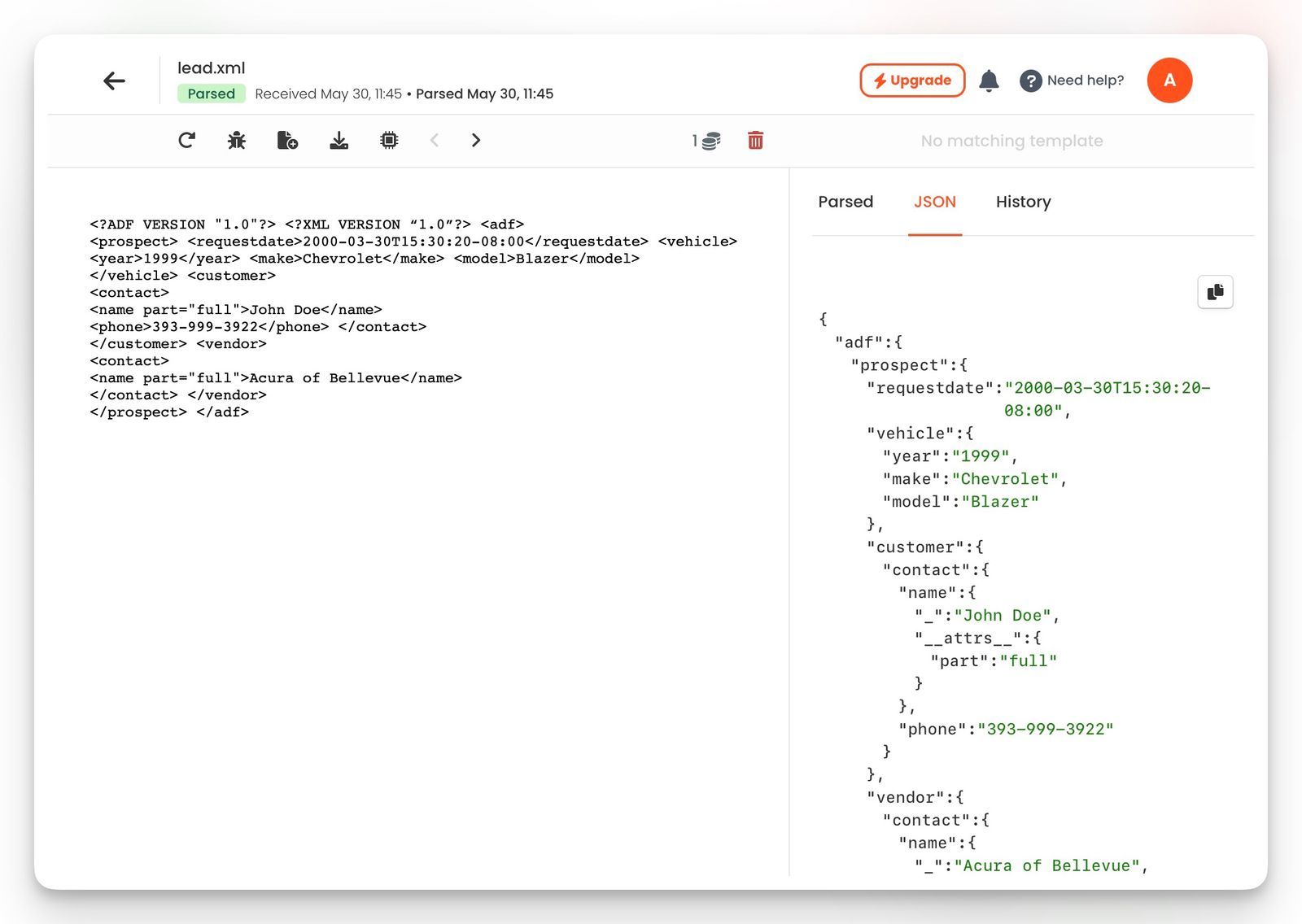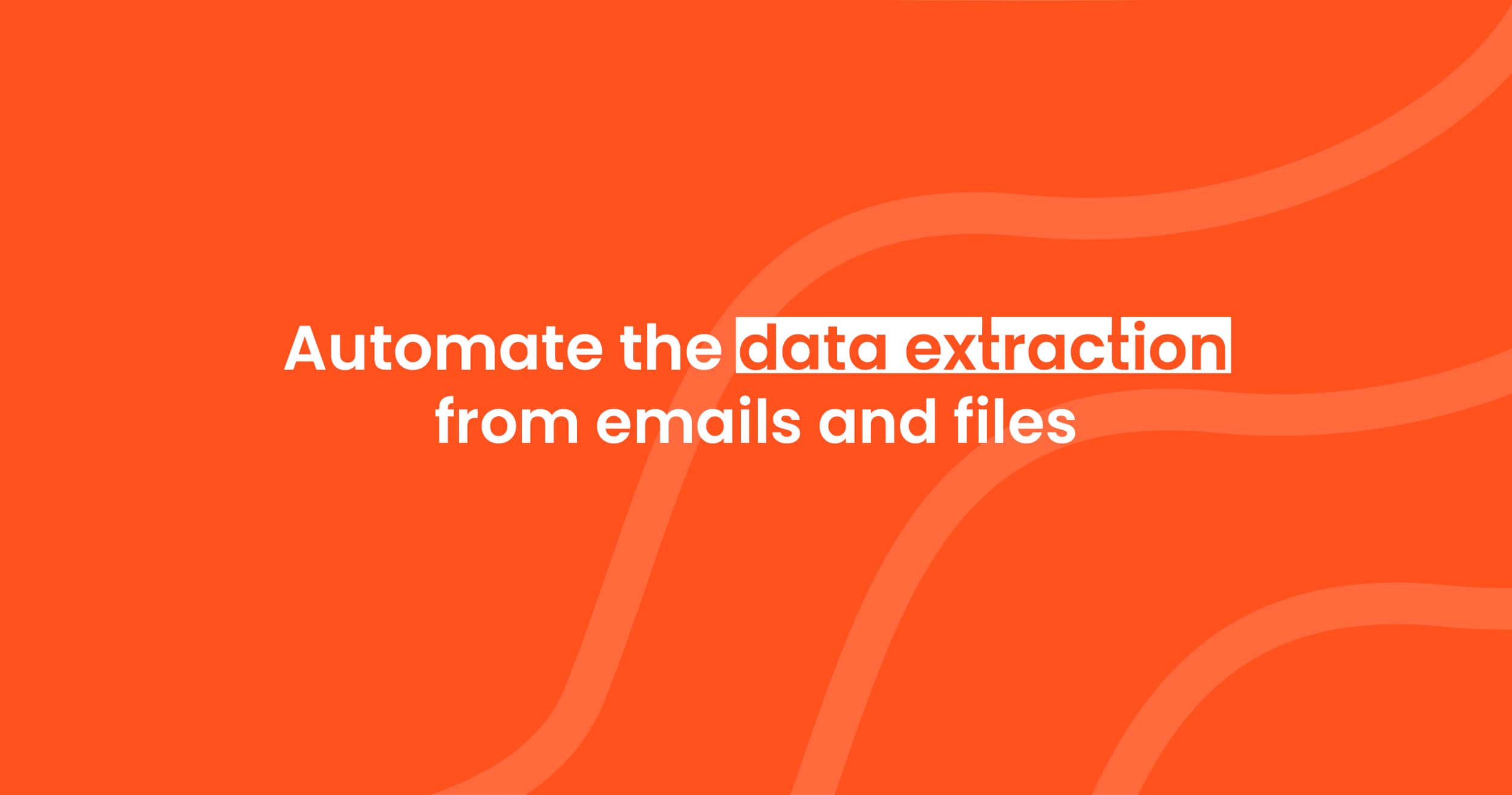Extracting data from ADF XML emails using Parsio

In the automotive industry, efficient lead management is crucial for success. ADF XML (Auto-lead Data Format) has emerged as the standard for transmitting lead information between consumers, dealerships, and service providers. This format allows for seamless integration of lead data into automotive Customer Relationship Management (CRM) systems.
Parsio offers a powerful solution for extracting valuable lead data from ADF XML emails, automating the process and saving time for dealerships and automotive businesses. By leveraging Parsio's capabilities, companies can quickly transform raw XML data into structured, actionable information. This streamlined approach enables faster response times to potential customers and improved overall lead management efficiency.
The ADF XML format contains essential details about prospective buyers, including contact information, vehicle preferences, and purchase intentions. Extracting this data accurately and promptly is vital for automotive businesses to stay competitive in a fast-paced market. With Parsio's automated extraction tools, dealerships can focus on nurturing leads and closing sales rather than manually processing incoming lead information.
Parsio automatically extracts all essential data from the ADF XML format:

Understanding ADF and Its Importance in the Automotive Industry
ADF (Auto-lead Data Format) is a crucial standard in the automotive industry for sharing lead information between vendors, dealers, and CRM systems. It streamlines communication and enhances data management for automotive businesses.
Basics of ADF XML Format
ADF uses XML language to structure lead data. This format organizes information into nested nodes, making it easy for systems to parse and process. Key elements in ADF XML include:
- Customer details (name, contact information)
- Vehicle preferences (make, model, year)
- Lead source and timestamp
ADF XML allows for consistent data transfer across different platforms. It ensures that all relevant lead information reaches dealers efficiently.
Here's an example of a lead in XML ADF format:
<?ADF VERSION "1.0"?>
<?XML VERSION “1.0”?>
<adf>
<prospect>
<requestdate>2000-03-30T15:30:20-08:00</requestdate>
<vehicle>
<year>1999</year>
<make>Chevrolet</make>
<model>Blazer</model>
</vehicle>
<customer>
<contact>
<name part="full">John Doe</name>
<phone>393-999-3922</phone>
</contact>
</customer>
<vendor>
<contact>
<name part="full">Acura of Bellevue</name>
</contact>
</vendor>
</prospect>
</adf>Role of ADF in Customer Relationship Management
ADF plays a vital role in automotive CRM systems. It enables:
- Seamless lead import from various sources
- Standardized data formatting for easy processing
- Efficient lead distribution to sales teams
By using ADF, dealers can quickly receive and act on leads. This standardization improves response times and customer service.
ADF also supports sales automation by providing structured data for follow-ups and analytics. It helps dealers track lead sources, conversion rates, and customer preferences more effectively.
Extracting Lead Data from ADF XML Emails
ADF XML emails contain valuable lead information for automotive dealerships. Extracting this data efficiently requires setting up a proper parsing environment and mapping the XML fields to CRM systems.
Setting Up the Email Parsing Environment
To extract lead data from ADF XML emails, start by configuring your email parsing tool. Choose a reliable parser that supports XML formats. Set up email forwarding rules to automatically send incoming ADF emails to the parsing service. Create parsing templates that identify key XML tags within the ADF structure.
Configure the parser to recognize ADF 1.0 specifications. Define extraction rules for essential lead information such as:
- Customer name
- Contact details
- Vehicle preferences
- Purchase timeline
Test the parsing setup with sample ADF XML emails to ensure accurate data extraction. Implement error handling to manage invalid XML formats or missing fields.

Mapping ADF XML Fields to CRM
After extracting lead data, map the ADF XML fields to corresponding fields in your CRM system. Create a standardized mapping table that aligns ADF elements with CRM data points. Common mappings include:
| ADF XML Field | CRM Field |
|---|---|
| customer.name | Full Name |
| customer.email | Email Address |
| vehicle.make | Preferred Make |
| vehicle.model | Preferred Model |
Develop integration scripts to automatically populate CRM records with parsed lead data. Implement data validation checks to ensure the quality of imported information. Set up alerts for any parsing errors or data inconsistencies.
Consider creating custom fields in your CRM to capture unique ADF XML elements. Regularly review and update the mapping process to accommodate changes in ADF specifications or CRM requirements.
Integrations and Automation Using ADF XML
ADF XML enables seamless integration with automotive dealership systems and streamlines sales processes. This standardized format facilitates efficient lead management and enhances customer service capabilities.
Connecting ADF XML with CRM Systems
ADF XML integrates smoothly with Customer Relationship Management (CRM) systems used by dealerships. API connections allow for real-time data transfer between lead providers and CRM platforms. This ensures sales teams have immediate access to new leads.
Automated import processes map ADF XML fields to corresponding CRM fields. Contact details, vehicle preferences, and lead source information populate customer records automatically. This eliminates manual data entry and reduces errors.
Many CRM vendors offer built-in ADF XML support. Salesforce, DealerSocket, and VinSolutions are examples of CRM systems with native ADF XML parsing capabilities.
Streamlining Sales Processes with ADF XML
ADF XML accelerates the sales cycle by delivering qualified leads directly to dealership staff. The structured format allows for intelligent lead routing based on criteria like vehicle interest or location.
Automated email responses can be triggered upon lead receipt. These messages confirm the inquiry and provide next steps, improving customer experience.
Sales teams benefit from comprehensive lead data in ADF XML. Details like trade-in information and preferred contact methods help tailor follow-up strategies.
ADF XML also facilitates lead tracking and performance reporting. CRM systems can generate insights on lead sources, conversion rates, and sales team effectiveness.
Best Practices and Common Pitfalls
Extracting data from ADF XML emails requires careful attention to detail and adherence to established standards. Proper validation, compliance checks, and error handling are crucial for successful data extraction.
Ensuring ADF XML Validity and Compliance
ADF XML files must adhere to strict formatting standards to be considered valid. Use XML validators to check file structure and syntax. Ensure all required fields are present and properly formatted. Keep abreast of industry updates to ADF specifications.
Implement rigorous quality control measures. Regularly audit extracted data for accuracy and completeness. Train staff on ADF XML standards and best practices.
Consider using automated tools to validate ADF XML files before processing. These tools can catch common errors like missing tags or invalid data types quickly and efficiently.
Avoiding and Addressing Common Errors
Invalid XML structure is a frequent issue. Missing closing tags or improperly nested elements can cause parsing failures. Use XML linting tools to identify and correct structural problems.
Data inconsistencies often occur between different CRM systems. Dealersocket and Eleadson may format certain fields differently. Implement data normalization routines to standardize extracted information.
Incomplete lead information can result from outdated ADF templates. Ensure your parsing system supports the latest ADF version and can handle optional fields gracefully.
Character encoding issues may cause garbled text. Always specify and check for proper UTF-8 encoding when processing ADF XML files.

